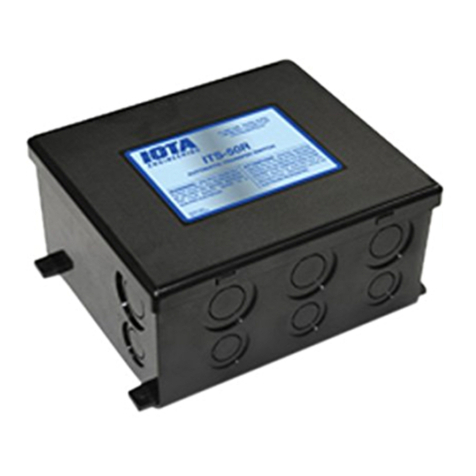
OPERATIONAL TESTING
READ AND FOLLOW ALL SAFETY INSTRUCTIONS
I. Plug in the powercord. If the main panel circuit breakers are
switched on, RV load should operate normally. Unplug the
powercord.
II.Start the generator.There is a pre-programmed 20-30 sec-
onddelayin thetransferswitch.The delayis designed to allow
thegeneratorabriefwarm-upperiod.Whenthedelaycompletes
its cycle the switch should engage and the RV load should
operate normally.An audible click should sound as the switch
engages.
III.Shut down the generator.As the generator winds down the
switchshould disengage without chatteror cycling. An audible
click should sound as the switch disengages.
IV. Plug in the powercord. Start the generator. After the pre-
programmeddelay,theswitch shouldtransfer powerautomati-
callyfromthepowercordtothegenerator.Listenforthe audible
click as the switch transfers, as there will likely be no other
indicationthat the switch has engaged.Shut down the genera-
torand unplug the powercord.
V.On transferswitch arrangementswiththree powersupplies,
plug in the powercord, start the generator, and turn on the in-
verter.With all three supplies energized at the same time, the
switch will select the generator for the primary supply choice.
Shut down the generator. The switch will transfer to the
powercord. Unplug the powercord.The switch will transfer to
the inverter.Theinverter should always be connected so that it
is only selected in the absence of both the other supplies.
TROUBLESHOOTING
I. LOWVOLTAGE: Low voltage is harmful to most appliances.
Contactor-basedtransfer switchesarealso affectedbylowvolt-
age; if the voltage level drops far enough the contactor points
will “chatter”. Sustained contact chattering can cause transfer
switchdamage.Switchesthathavebeendamagedbychatter-
ing need to be returned to the factory for replacement.
GENERAL LOW VOLTAGE: Low voltage can be caused by
low voltage conditions such as an RV park with inadequate
wiring forcrowdedcamper conditions where everyone’s elec-
tricity suffers (brownout). In this case a voltmeter will be help-
ful and will show a low voltage reading from the park recep-
tacle, even before the RV is plugged in.When you experience
generallowvoltageconditions,remember,that brownoutscan
beharmfulto most appliances. A betteralternativemight be to
utilize the generator until park voltage conditions improve.
LOCALIZED LOWVOLTAGE:Low voltage conditions can be
causedby specific situations such asanadditional cord which
istoo long and toosmall for the load.Do not attempt toextend
the RV powercord by using a 16 gauge 100 foot extension
cord,or anycordnot rated for an RV-size load.A localizedlow
voltage condition will result when a load is turned on which is
larger than that which the cord is designed for.Assoon asthe
RVtriestodrawmorecurrentthantheamountforwhichthecord
is rated, the voltage will fall
within the length of the cord,
and the
RVwillexperiencelowvoltage.This is especiallynoticeabledur-
ing inrushcurrent situationssuch asan air conditioner start-up.
Contactor-based transfer switches are affected by this.The
compressor will try to start, the voltage will drop, which will
cause the contactor to drop out, at which point the voltage
willrisetothepre-inrushlevel.Thecontactswillchatter when
theA/Ccompressorkicksin,howeverthevoltagemayread
normal.Most meters are notfast enough torecord this volt-
age drop.You can test for low voltage readings during this
inrushcyclebyreadingvoltageatthecontactorterminalswhile
manuallyholdingthecontactorplungerdowninitsclosedpo-
sition.Thiswilloverridethechatteringconditionandthemeter
willhave timeto registerthe reducedvoltage. If thiscondition
exists, identify and correct the low voltage situation before
proceedingfurther.
PHYSICAL INTERFERENCE:Some transfer switchmod-
elshavewiring connections made by wirenutson6″leads.
Occasionally on these models, the wiring connections will
getfolded into the can in such a mannerthat the wiringwill
interfere with the physical operation of the relay. Visually
inspect for free operation of the relay(s).
TIME DELAY BYPASS SWITCH:The time delay function
in the control module on some models may be bypassed.
Relay-based transfer switches have incorporated into the
controlmodule board a smallswitch which allows thetech-
nician to activate or bypass the time delay.The time delay
is necessary during generator start-up so that the genera-
tor does not have to start under load;the delay is not nec-
essary for powercords or inverters. Therefore in transfer
switch operation where the module is controlling a supply
other than a generator, the delay switch should be set to
the bypass (ON) position. This will allow instantaneous
switching. Another time for bypassing the delay is during
diagnostic and troubleshooting efforts; if bypassing the
delay causes the switch to work when it otherwise won’t,
thenthe time delay has malfunctionedandtheboardshould
be replaced.To bypass the time delay, locate the switch on
the end of the circuit board and select the position on the
switch marked ON. Time delay bypass is now activated,
andtransfer will be instantaneous.
FAILEDTIME DELAY CONTROL MODULE: It is possible
for a voltage spike, etc. to cause the time delay module to
fail:ifthishappenstheswitchwill no longer transfer.Transfer
Switchmodels have a diagnosticLED mounted on thecon-
trolmodulecircuitboard.If themoduleisreceiving120VAC
inputandisoperatingproperly,theLEDwill belit.Thismeans
thecontrolmodulehastimedforthe20-30seconddelayand
is now providing power to the coil on the relay.If the module
input is energized and the LED does not light after 30 sec-
onds, the time delay function in the module has failed, and
the module should be replaced.To verify this, try setting the
timedelayswitchontheboardtothedelaybypassposition;
the switch should transfer with no delay.
Note that this posi-
tion will allow emergency operation until the module can be
replaced;howeverthere willnot bea 20-30 seconddelay for
generator start-up
. All repairs should begin by unplugging
andreplacing the control modulefirst.However, if the LED is
on and the switch is not working, then the control module is
functioningproperly andtheswitchhasother problems,such
asa failedrelayor contactor,andthe entire switchshouldbe
returnedfor replacement.
























